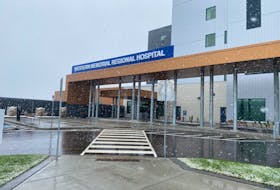CORNER BROOK, N.L. — Corner Brook’s battle to get a positron emission tomography (PET) scanner when its new hospital is built has spawned a veritable cottage industry of promises, opinions and speculation.
It’s the quintessential political football, and Dr. David Webster has seen it all before.
Webster, a nuclear medicine specialist and patient advocate in Sudbury, was front and centre in a lengthy lobby to acquire a PET scanner for that western Ontario city.

When it was finally installed in 2019, however, Webster publicly criticized policies that limited its use. That earned him a formal caution from the Ontario College of Physicians and Surgeons for “non-collegiality.”
“You think people are just ‘re-educated’ in China,” he said wryly in a recent interview. “You only have to come to Ontario. I was re-educated by the College of Physicians and Surgeons.”
Webster says he has good reason to be cynical. He claims Ontario is one of the most restrictive jurisdictions in the world when it comes to deciding when and how the equipment gets used.
“Right now, basically, we’ve got a Jaguar that we’re using to drive our garbage to the roadside,” he said. “That’s the equivalent of what we’re using it for.”
Expensive to run
There are practical reasons for restricting usage. The main one is operating expense.
Once you have it installed, a PET scanner can cost anywhere from $1.4 million to $2 million a year in salaries and overhead.
Webster says federal bureaucracy also drives up the price tag.
The substance used to light up trouble spots in the body’s cells, a radioactive sugar compound called fleurdeoxyglucose (FDG), is heavily regulated.
“They charge $250 for every dose of FDG just to keep the bureaucrats in Ottawa happy,” he said.
“In Ontario, we have the most expensive FDG in the world.”
Webster compares it to a box of iodized salt. Iodine can be deadly, but iodine in salt is so miniscule that it’s harmless. Yet, Ottawa considers radioactive medical tracers to be pharmaceuticals under laws that were written, Webster jokes, “at the time of the Irish Potato Famine.”
Tracer decay
Tracers are a problem for another reason.
When the St. John’s scanner was just the germ of an idea in 2009, the authors of a study for the Newfoundland and Labrador Centre for Applied Health Research pointed out that flying tracers in from Halifax would mean a big loss in radioactivity, since the half-life of FDG is about two hours.
That means every two hours, its radioactivity drops by half.
“This travel time will result in a loss of at least two half-lives, which would require ordering four times as much activity as would be needed to account for in-transit decay,” they said.
Transporting it by road from the St. John’s cyclotron to Corner Brook would be even longer, meaning it would almost certainly have to be flown in.
“It may actually be more cost-effective to bring them to St. John’s and image at a central site in a place like Newfoundland." — Dr. David Webster
The question then becomes, would it be cheaper to fly patients to it?
Webster doesn’t know the local circumstances, but agrees it should be a consideration.
“It may actually be more cost-effective to bring them to St. John’s and image at a central site in a place like Newfoundland,” he said.
Another impediment, Webster suggests, is that some health authorities and radiologists are still stuck in the mindset of using multiple CT scans and MRIs to track the growth of cancer cells — sometimes to the point of exceeding recommended radiation exposure for the patients.
That, he says, is inefficient and can even be cruel.

High on the list
Comprehensive data released last month by the Canadian Agency for Drugs and Technology in Health (CADTH) paint an interesting picture of how imaging technology was used in Canada in 2019-20.
Webster points to Quebec as the model for fully embracing PET technology, and the numbers seem to show it.
According to the CADTH, the average number of PET-CT scans (modern scanners usually combine both) per 1,000 residents in Canada is 3.3 — which, ironically, is exactly where Newfoundland and Labrador falls.
Quebec is way ahead at eight per 1,000, while Ontario and Manitoba are tied for the lowest at 1.6.
If Corner Brook got its wish today, Newfoundland would be the most scanner-rich province in Canada, with 3.8 per million population.
Quebec also has the most scanners per million population, at 2.7, although Newfoundland is again slightly above the national average at 1.9 compared to 1.5.
If Corner Brook got its wish today, Newfoundland would be the most scanner-rich province in Canada, with 3.8 per million population.
Still, the day before the election call, the Liberals hastily offered a downpayment for a PET scanner — or better — at some nebulous point in the future.
The PCs vow the scanner will be there on Day 1.
The NDP avoided taking a firm stand, and because of it a local candidate withdrew from the campaign.
Deciding how many scanners any province needs has always been tangly.
Newfoundland and Labrador spends more on health care per capita than any other province, but governments attribute much of that to a sparse population spread over a challenging geography, split between the island and Labrador.
The premier’s Health Accord Task Force — which is scheduled to start public consultations on Monday — aims to look at ways to change how health care is administered in the province.

So, while politicians are dutifully promising not to cut hospital budgets, adding another piece of Cadillac equipment might seem counter-intuitive.
By most accounts, the $2 million the Liberal government promised for the PET scanner won’t come near to covering the cost.
In Sudbury, the PET-CT scanner cost $5 million, and even price ranges in studies from a decade ago put one at between $2.4 million and $4 million.
Eastern Health built an entire new nuclear medicine facility for its $3.6-million PET scanner in 2016-17, and added a $6.6-million cyclotron to provide a reliable source for radiopharmaceuticals.
The total project cost $46 million.
After some back and forth with the Western Regional Hospital Action Committee last month, Liberal Leader Andrew Furey admitted the money is only a down payment — sort of.
“While government is honouring the original commitment of former premier (Dwight) Ball, my administration has taken that commitment several steps further,” he wrote in a letter. “We have given the Health Foundation the money needed to purchase the PET scanner, directed them to begin the process of securing the appropriate model and securing its purchase with a down payment.”
Webster admits cost shouldn’t be the only factor.
“In the end, it probably is cheaper — we joked about this — to put a PET scanner in Pearson airport in Toronto and bring people to it.”
Playing catch-up
Despite it all, Webster says PET scanners have been the gold standard for medical imaging for at least two decades, and Canada is late getting on board.
The main advantage is they take the guesswork and long delays out of cancer diagnosis, though they are also useful for detecting other problems such as neurological changes.
FDG is taken in by cells, but they can’t metabolize it like regular sugar, so it lingers where it is and the dim radioactive glow can be detected by the scanner.
Cancer cells can only metabolize sugar, said Webster.
“They also need an enormous amount of it to do the work that they do.”
Not only can a PET scan guide a biopsy needle to an exact spot, it can even indicate the aggressiveness of the cancer ahead of time.
In some cases, that helps avoid putting patients through hell when their prospects are grim.

Webster described the case of a nurse who was denied a PET scan, but rather staged for cancer treatment using CTs and MRIs.
She agreed to intense radiation followed by invasive surgery that resulted in colon and bladder issues.
A PET scan later showed she had had Stage IV, untreatable cervical cancer from Day 1.
“This treatment was absolutely contraindicated,” Webster told The Sudbury Star in 2019. “If we had known that, and obviously, the PET scan would have shown that, she never, ever should have had this therapy.”
PET scanners, he says, offer the opportunity to provide true personalized care, rather than the old “cookbook” approach of using the same recipes to treat cancer according to what inferior imaging showed.
@pjackson_nl
Peter Jackson is a Local Journalism Initiative reporter covering health for The Telegram.









